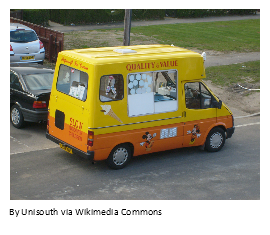 A few years ago, I spent a fascinating week travelling around Europe. I was trying to put together a consortium to bid for funding from an EU industrial research programme. I was selling a vision. It was one of those “if its Wednesday I must be in France” trips, where after a couple of days my brain’s language processor gets so confused it just gives up attempting anything except English. Fortunately (but as usual), my hosts all put me to shame by speaking excellent English to me.
This trip taught me a very important lesson about selling a vision which I have used many times since. No organisation wants to be the first to commit to partnering when all they have is an outline description of the objectives of the partnership. They feel they need to know who else will be a part of it, and what the content of the programme will look like. Without this, they don’t even really want to share their ideas of what they might contribute or what benefits they might receive. On the other hand, until they do share their ideas it is impossible to put together a realistic programme. So where do you begin?
I describe what I did as “Castles in the air”. Think of the project as a fairy-tale castle floating above the ground. You have to be able to describe in some detail what this castle looks like from a distance. Of course, no-one can actually get to it to look inside, so much of the detail does not need to be filled in, but the description has to be convincing enough that everyone believes it is a real castle, not an illusion. In particular, they must never think that there is nothing holding it up!
A few years ago, I spent a fascinating week travelling around Europe. I was trying to put together a consortium to bid for funding from an EU industrial research programme. I was selling a vision. It was one of those “if its Wednesday I must be in France” trips, where after a couple of days my brain’s language processor gets so confused it just gives up attempting anything except English. Fortunately (but as usual), my hosts all put me to shame by speaking excellent English to me.
This trip taught me a very important lesson about selling a vision which I have used many times since. No organisation wants to be the first to commit to partnering when all they have is an outline description of the objectives of the partnership. They feel they need to know who else will be a part of it, and what the content of the programme will look like. Without this, they don’t even really want to share their ideas of what they might contribute or what benefits they might receive. On the other hand, until they do share their ideas it is impossible to put together a realistic programme. So where do you begin?
I describe what I did as “Castles in the air”. Think of the project as a fairy-tale castle floating above the ground. You have to be able to describe in some detail what this castle looks like from a distance. Of course, no-one can actually get to it to look inside, so much of the detail does not need to be filled in, but the description has to be convincing enough that everyone believes it is a real castle, not an illusion. In particular, they must never think that there is nothing holding it up!
Selling a vision
Putting that into project terms, there has to be a clear vision of what the project could do, broadly who may be involved and how they will benefit, even though none of it is agreed, and you have to feel and sound confident about it, just in order to get people talking about how they might contribute. Once you can get possible contributors to engage, they will help you fill in the detail, adapt the vision and underpin it with the foundations, until the whole project is solid enough to stand up by itself. The same principles apply to any situation where you need to influence many different people to win their support for the same idea. Unless you can describe your “castle in the air” with confidence, as though it were real and solid, it will be very difficult to get a hearing at all. The more people listen and contribute, even if they are not yet fully convinced, the easier it gets to win over others. I have recently moved house. I moved from a small and very ordinary town in Oxfordshire to a bustling area of London. What a contrast! From largely white to multi-cultural, from sleepy to vibrant, from staid dormitory to entrepreneurial.
One of the big differences is shopping. In Oxfordshire, there was little choice but to buy all your groceries from one of the big supermarkets. When I first lived there, there were many butchers, greengrocers and bakers. Over the years they have all shut up shop, unable to compete with the demand for the convenience of "all I need under one roof" and "open when I get home from work", even if supermarket prices can be high. Here I am spoilt for choice, especially with butchers, fishmongers and greengrocers. What a delight to be able to wander up and down the stalls, with the noise of vendors shouting out offers, with the bright colours of peppers, tomatoes, oranges and lemons and the indefinable smells, looking for the freshest, the fattest, and (wishfully) the tastiest.
I have recently moved house. I moved from a small and very ordinary town in Oxfordshire to a bustling area of London. What a contrast! From largely white to multi-cultural, from sleepy to vibrant, from staid dormitory to entrepreneurial.
One of the big differences is shopping. In Oxfordshire, there was little choice but to buy all your groceries from one of the big supermarkets. When I first lived there, there were many butchers, greengrocers and bakers. Over the years they have all shut up shop, unable to compete with the demand for the convenience of "all I need under one roof" and "open when I get home from work", even if supermarket prices can be high. Here I am spoilt for choice, especially with butchers, fishmongers and greengrocers. What a delight to be able to wander up and down the stalls, with the noise of vendors shouting out offers, with the bright colours of peppers, tomatoes, oranges and lemons and the indefinable smells, looking for the freshest, the fattest, and (wishfully) the tastiest.
The right price
One thing though took me by surprise. The price of bananas. Most of the market fruit and vegetables are good value by comparison with the supermarkets. But bananas? I’d guess the market price is about double the price in supermarkets! What is the right price? What is going on? The big chains compete with each other, not with market traders. If one shop puts a price down, the others pretty much follow suit. If one decides that bananas are to be a loss-leader, probably the rest do too. And this sort of pricing is like a ratchet – if it becomes established, it is very hard to move it in the other direction. The supermarkets may paint themselves into a corner. Pricing matters – and not just because companies exist to make a profit. Price sends a signal about what something is worth. “You get what you pay for” as the saying goes. Paradoxically, you may get more people coming to an event for which they have to buy a ticket than will come to one that is free, because the free event is not valued. Needing an income, I once took a job which paid considerably less than I had previously been earning. Result? I got very bored because no-one thought to use my higher skills. I was pigeon-holed by my price, and I left as soon as I could. Pricing that does not match value may serve a necessary short term purpose, but in the end it serves no-one very well. The right price matters. It’s about 5°C outside, and I’ve just heard the chimes of the ice-cream van. Yes, I know its nearly April, and the daffodils are trying to come out, but who would want to put a coat on and go and shiver in the road for five minutes, just to eat something … very cold?
It’s about 5°C outside, and I’ve just heard the chimes of the ice-cream van. Yes, I know its nearly April, and the daffodils are trying to come out, but who would want to put a coat on and go and shiver in the road for five minutes, just to eat something … very cold?

